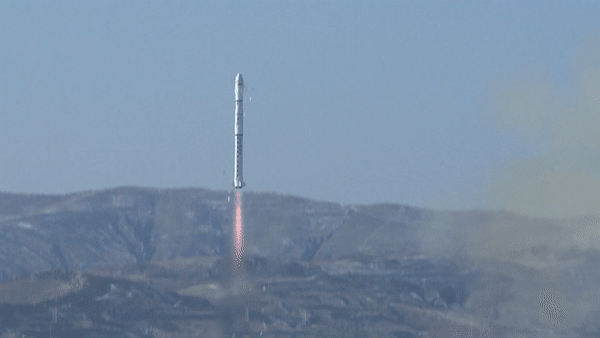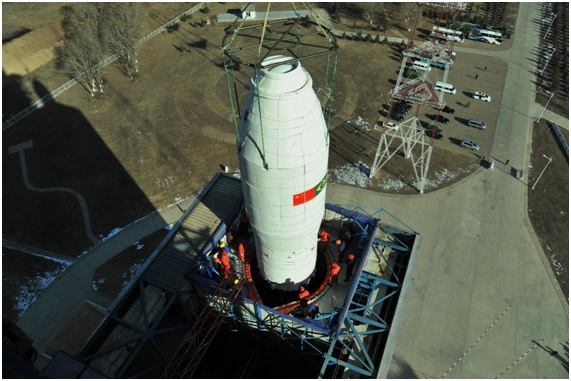Long March Rocket Launches Chinese-Brazilian Mission and 1st Ethiopian Satellite
China successfully launched nine satellites early on Friday (Dec. 20) as the country cements its place at the top of the 2019 launch table.
The launch took place at 11:22 a.m. local time on Dec. 20 (0322 GMT, or 10:22 p.m. EST Dec. 19). The mission was delayed by three days due to unfavorable weather conditions.
The satellites were launched by a Long March 4B rocket, which uses hypergolic hydrazine and nitrogen tetroxide for propellant, producing distinctively colored exhaust patterns.
Video: China's Rocket 'Cries' Ice While Launching 9 Satellites
Related: China Launches 2 Rockets Within 3 Hours in Latest Space Rally (Videos)

Chinese state news outlet CCTV released footage of the liftoff from the Taiyuan Satellite Launch Center in northern China. The video shows insulation tiles falling away as the rocket begins to climb from snow-sprinkled hills.
The main payload was the 3,810-lb. (1,730 kilograms) joint China-Brazil remote-sensing satellite CBERS-4A, which will provide medium-resolution imagery of the Amazon rainforest and other areas.
Also onboard was Ethiopia's first satellite, the 150-lb. (70 kg) ETRSS-1, a remote-sensing satellite developed with support from China. "The satellite will provide all the necessary data on changes in climate and weather-related phenomena that would be utilized for the country's key targets in agriculture, forestry, as well as natural-resources-protection initiatives," Ethiopian President Sahle-Work Zewde told the Ethiopian parliament in August.
Get the Space.com Newsletter
Breaking space news, the latest updates on rocket launches, skywatching events and more!
Ethiopia has now joined nine other African nations — South Africa, Nigeria, Rwanda, Algeria, Egypt, Angola, Morocco, Ghana and Kenya — in having a satellite in orbit.

Among the seven other satellites on the mission was Tianqin-1, a technology verification satellite for a future space-based gravitational wave detection constellation. Tianqin satellites will use inter-spacecraft laser interferometry to pick up the ripples in space-time, or gravitational waves, created by the collision of massive objects such as black holes.
The other small satellites were FloripaSat-1, a Brazilian cubesat developed by university students; two small satellites developed by China's National University of Defense Technology; and three cubesats from MinoSpace, a private Chinese small satellite maker established in 2017.
China has been the busiest space power in 2019, carrying out 33 launches this year so far. Two of the launches ended in failure, while a separate satellite, ChinaSat-18, was lost when it failed to communicate with the ground. U.S. rockets have launched 27 times this year, with no failures during launch, including Rocket Lab launches from New Zealand.
Earlier in the week, China launched a pair a Beidou navigation satellites — and more launches are expected before the year is out. The biggest mission of the year, on which many of China's major plans depend, will be the return-to-flight mission of the Long March 5 rocket, expected on Dec. 27.
- CubeSats: Tiny Payloads, Huge Benefits for Space Research
- China Launches 2 Beidou Navigation Satellites, Nearly Completing Constellation
- China's Private 'Smart Dragon-1' Rocket Aces 1st Mission
Follow Andrew Jones at @AJ_FI. Follow us on Twitter @Spacedotcom or Facebook.

Join our Space Forums to keep talking space on the latest missions, night sky and more! And if you have a news tip, correction or comment, let us know at: community@space.com.

Andrew is a freelance space journalist with a focus on reporting on China's rapidly growing space sector. He began writing for Space.com in 2019 and writes for SpaceNews, IEEE Spectrum, National Geographic, Sky & Telescope, New Scientist and others. Andrew first caught the space bug when, as a youngster, he saw Voyager images of other worlds in our solar system for the first time. Away from space, Andrew enjoys trail running in the forests of Finland. You can follow him on Twitter @AJ_FI.









